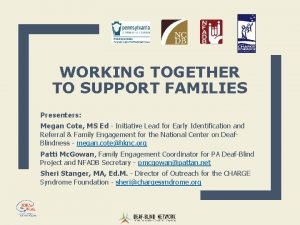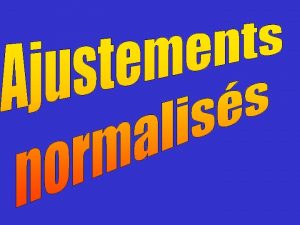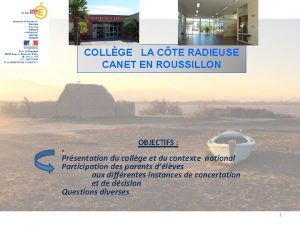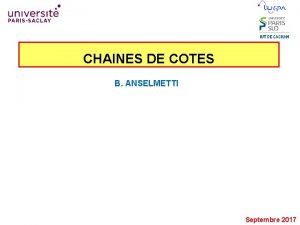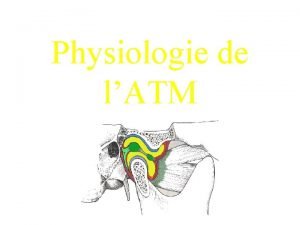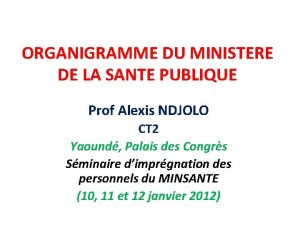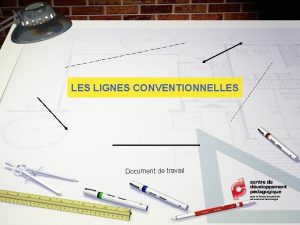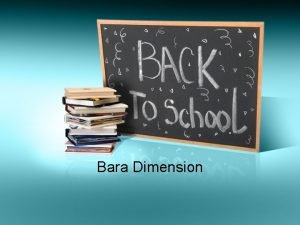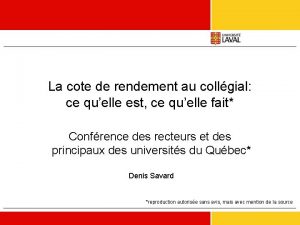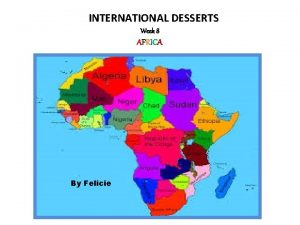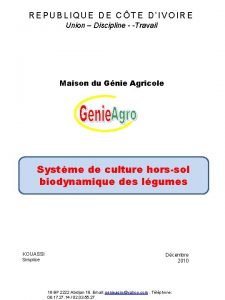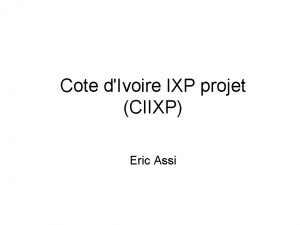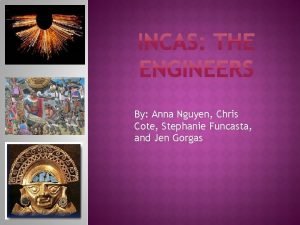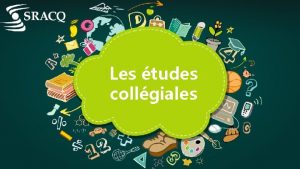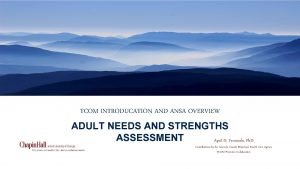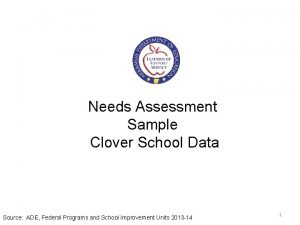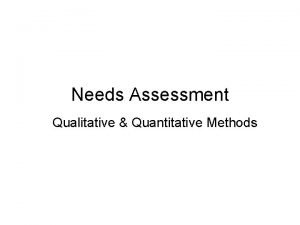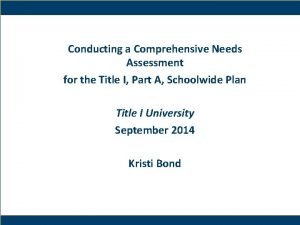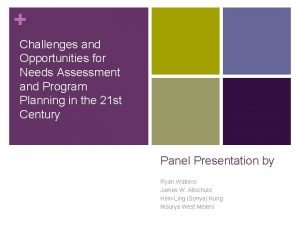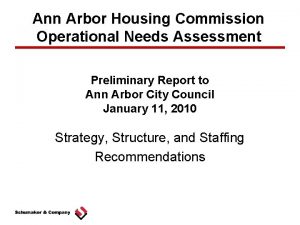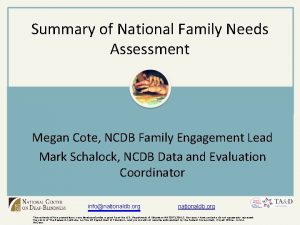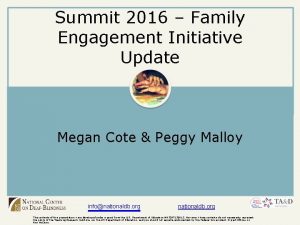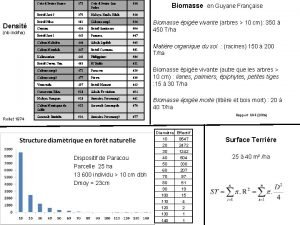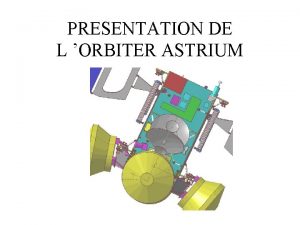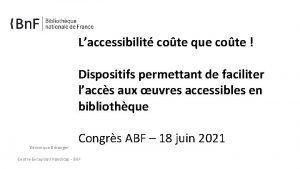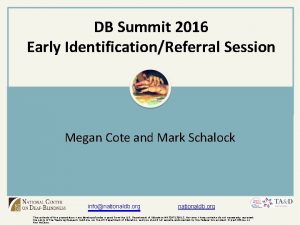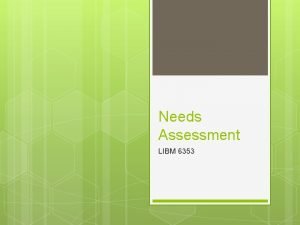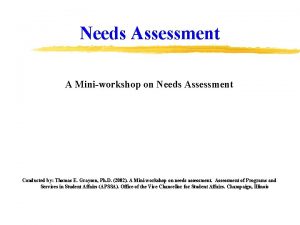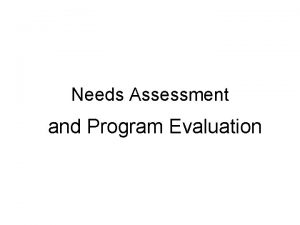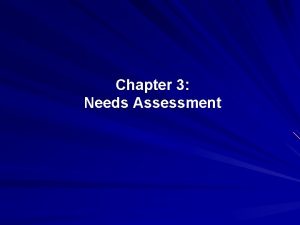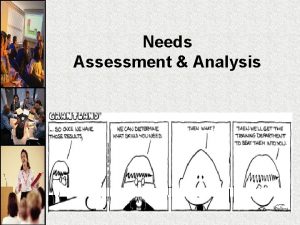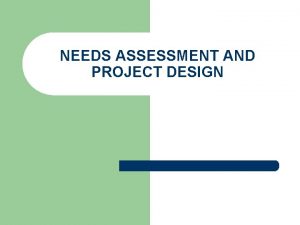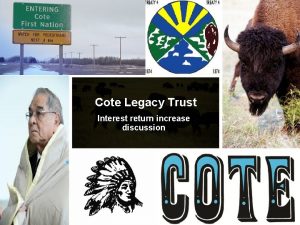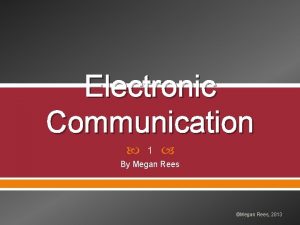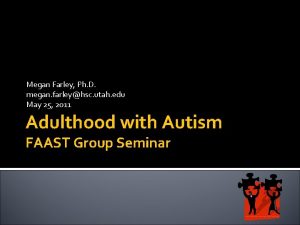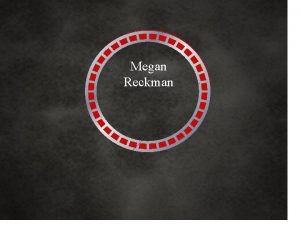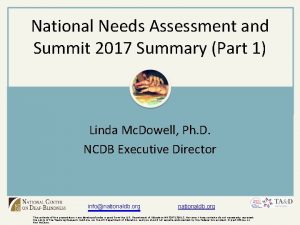Summary of National Family Needs Assessment Megan Cote






























- Slides: 30

Summary of National Family Needs Assessment Megan Cote, NCDB Family Engagement Lead Mark Schalock, NCDB Data and Evaluation Coordinator info@nationaldb. org The contents of this presentation were developed under a grant from the U. S. Department of Education #H 326 T 130013. However, those contents do not necessarily represent the policy of The Research Institute, nor the US Department of Education, and you should not assume endorsement by the Federal Government. Project Officer, Jo Ann Mc. Cann.

Overview of the Assessment I. Background II. Child and Family Needs and Strengths III. Experiences with Agencies, Programs and Service Providers IV. Experience and Interactions with other Families V. Local, State and National Supports

I. BACKGROUND Section I focuses on the recruitment of Families, number of responding families, and some demographics of their children.

Recruitment of Families • • State Deaf-Blind Projects NFADB Charge Syndrome Foundation NCDB English and Spanish versions On-line as well as paper-pencil versions 184 families responded to one or more items

Current Age of Children (N=184) • Youngest = less than 1 year of age • Oldest = 61 years of age • Average = 12 years 3 months • • Birth – 2 Pre-school age (3 -5) Elementary school age (6 -11) Middle/High school age (12 -17) Young adults age 18 -21 Young adults ages 22 -30 Over 30 = 9 = 38 = 54 = 42 = 25 = 10 = 7

Age of Diagnosis of Deaf-Blindness (N=182) • • At birth = 54 Before 1 year old = 34 1 -2 years old = 47 3 -5 years old = 29 6 -10 years old = 15 Older than 10 years = 2 Not sure = 1

Age when Connected to State Deaf. Blind Project (N=132) • • At birth =8 Before 1 year old = 14 1 -2 years old = 28 3 -5 years old = 38 6 -11 years old = 21 Older than 11 years = 7 Don’t Remember = 16

Referral to State Deaf-Blind Project (N=63) Who referred you to State Deaf-Blind Project 1. Part C Provider (22%) 2. School Personnel (19%) 3. The SDBP contacted me (13%) 4. Hospital/medical professional (11%) 5. Another parent or friend (10%) 6. I sought them out (8%) 7. Social worker/other program or agency (6%) 8. Don’t remember (11%)

II. NEEDS AND STRENGTHS Section II focuses on the needs of children as well as the needs and strengths of families.

Child Needs (N=180 respondents; 485 responses) What are current top needs you have for your child? Most frequent responses 1. Communication system 2. Qualified knowledgeable personnel at local level 3. Social engagement 4. Health 5. Independent living and functional living skills 6. Supports in the home and community 7. Parent training to support our child

Areas of Child Needs What are the current Greatest areas of need for your • General/cut across (e. g. child? communication, qualified personnel, etc. ) • Community engagement/supports • Home supports • Medical/Health care • Post-Secondary/Adult Life • School

Family Needs (N= 154) What do you most need information about? (In order of frequency) 1. Assistive technology use 2. Communication methods and instruction 3. Advocacy skills to support my child in school and the community 4. Impact of vision and hearing loss 5. Helping my child build social skills and friendships 6. Building a network of support for my child 7. Transition to adult life 8. Supporting my child with complex medical needs

More Family Needs What else do you most need information about? 9. Interveners in school 10. Dealing with challenging behaviors 11. Life of our child as an adult 12. Dealing with IEPs and assessments 13. Movement 14. Employment 15. Sibling support 16. Transition from early intervention to school

Family Strengths (N=124) Family characteristics and dynamics (n=123) • Our family is a strong team • Our adaptability, determination and patience • Love, humor and faith • Knowing and understanding our child • Being consistent • We allow our child freedom to explore • We focus on strengths and maintain high expectations • We include our child in all family activities • We celebrate successes

Family Strengths Our skills and abilities (n=102) • Taking care of educational and medical needs • Ability to advocate for our child • Ability to find resources • Ability to communicate with our child • Experience as educator(s) – teaching specific skills • Our ability (financial) to provide support Development of external supports (n=12) • Connecting with other families • Having external supports

III. EXPERIENCES WITH AGENCIES AND SERVICE PROVIDERS Section III focuses on the various agencies and service providers families deal with in supporting their child.

Satisfaction with Service Agencies/Programs (N= 166) State and Local School District/Department of Education (n=154); 69% have had positive experiences Part C Program (n=97); 75% have had positive experiences Developmental Disabilities (n=84); 42% have had positive experiences Vocational Rehabilitation (n=48); 38% have had positive experiences

Satisfaction with Service Agencies/Programs Other Medical System (n=130); 78% have had positive experiences Public Health System (n=60); 47% have had positive experiences Kellen Keller Regional Representative (n=56); 52% have had positive experiences Parent Center (n=38); 42% have had positive experiences Other local, state and national agencies/programs (n=43); 95%have had positive experiences

Educational Service Providers (N=162) Educational Personnel • Teachers – Special Education Teacher (143), Teacher of the Visually Impaired (126), Early Intervention Teacher (120), Regular Education Teacher (106), Teacher of the Deaf or Hard of Hearing (105), Teacher of the Deafblind (37) • Related Service Providers – SLP (150), OT (142), PT (138), School nurse (104), O&M (94), Interpreter (33) • Paraeducators – Paraeducators (84), Interveners (46) • Administrators – School administrator (96) – District administrator (63)

Medical/Social Service Providers (N=162) • Vision/Hearing Professionals – Audiologist (150), Ophthalmologist (142), Optometrist (110) • General Medical Professionals – Pediatrician (145), Physician (141), Public Health Nurse (31) • Social Service Personnel – Social Worker (68)

IV. EXPERIENCES AND INTERACTIONS WITH OTHER FAMILIES Section IV focuses on the experiences and interactions with family groups and other families.

Interactions with other Families (N=149) Frequency of Interactions with Other Families • Of the 149 respondents: – 74 (49. 7%) never communicate with other families – 53 (35. 6%) communicated 1 -2 times per month – 5 (3. 4%) communicated 3 -5 times per month – 17 (11. 4%) communicated more than 5 times per month

Preferred Interactions with Other Families (N=152) Means of Interaction • Of the 152 respondents: – 112 preferred in person interactions – 90 preferred private Facebook groups – 69 preferred phone calls – 69 preferred texting (& a few preferred email) – About 25% preferred some form of on-line communication (Skype, Facetime, Google Chat, etc. ) – Several respondents were not interested in communicating with other families

Experiences and Interactions with other Families(N=132) Parent Groups and Advocacy Efforts • Of the 132 respondents: – 69 indicated that there was a parent group in their state • 40 indicated they were active in their state parent group – 28 indicated that there wasn’t a parent group – 46 did not know or did not respond – 13 indicated that they were active in state and/or national advocacy efforts.

V. SUPPORTS Section V focuses on family supports at the local, state and national levels.

Decision Making Supports (N= 156) Who do Parents Rely on in Making Decisions (overall rankings in parentheses) 1. Themselves 2. 3. – Their own knowledge of their child (1) – Reading and self-study (3) Experts – – Service providers (Part C providers, teachers, physicians, etc. ) (2) State Deaf-Blind Project personnel (5) Trainings and workshops (4) Watching online videos (8) Other Families – Parent of a child who is deaf-blind (6) – Local or national parent group (7)

Most Helpful Supports Generally (N=112) Who has provided the most helpful supports 1. Other Families 2. State Deaf-Blind Project 3. CHARGE Syndrome Foundation 4. NFADB 5. HKNC 6. Usher Syndrome Foundation

Most Helpful Supports Specifically (N=112) What has been most helpful 1. Connections to other Families 2. Conferences and Parent Weekends 3. Facebook Groups 4. Resources/information used in home, community, school 5. One on one assistance, TA, training, etc. 6. Advocacy for/support in obtaining services in school and the community

Most Helpful SDBP Supports (N=102) Most Helpful State Deaf-Blind Project Supports 1. Parent workshops/weekends (45%) 2. One on one support to our family (26%) 3. Access to resources and information (25%) 4. TA to teams in school (23%)

Additional Comments (N=40) • Need more support groups for parents to connect and share (n= 13) • Need help navigating state programs and agencies – especially adult/community services and programs (6) • We need qualified personnel in our state: interveners and teachers (4) • We/I need more support from national organizations and projects (4) • Resources need to be easier for me to find (5) • Thank you for your supports/activities (8)
 Megan cote
Megan cote Primary needs and secondary needs
Primary needs and secondary needs Primary needs and secondary needs
Primary needs and secondary needs Alpha press murray
Alpha press murray Strategic gender needs and practical gender needs
Strategic gender needs and practical gender needs Definition of need analysis
Definition of need analysis Cote nominale définition
Cote nominale définition College la cote radieuse
College la cote radieuse Cote encadree plan
Cote encadree plan L'equidistance de la carte topographique
L'equidistance de la carte topographique Coté travaillant diduction
Coté travaillant diduction Organigramme sante
Organigramme sante Types de lignes dessin technique
Types de lignes dessin technique Elementele cotarii
Elementele cotarii Diagonales isométriques
Diagonales isométriques Formule cote z
Formule cote z Cote d'ivoire desserts
Cote d'ivoire desserts Republique de cote d'ivoire union discipline travail
Republique de cote d'ivoire union discipline travail Cote d'ivoire
Cote d'ivoire Jen gorgas
Jen gorgas Côte de granit rose carte
Côte de granit rose carte Lilymage
Lilymage Josh cote
Josh cote Choc pétrolier
Choc pétrolier Cote sracq
Cote sracq Adult needs and strengths assessment
Adult needs and strengths assessment Ade needs assessment
Ade needs assessment Needs assessment research method
Needs assessment research method Community needs assessment steps
Community needs assessment steps Challenges of needs assessment
Challenges of needs assessment Housing needs assessment
Housing needs assessment
